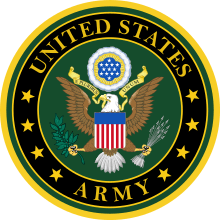Continental Army
The Continental Army was formed by the Second Continental Congress after the outbreak of the American Revolutionary War by the former British colonies that later became the United States of America. Established by a resolution of the Congress on June 14, 1775, it was created to coordinate the military efforts of the Thirteen Colonies in their ultimately successful revolt against British rule. The Continental Army was supplemented by local militias and volunteer troops that remained under control of the individual states or were otherwise independent. General George Washington was the commander-in-chief of the army throughout the war.
| Continental Army | |
|---|---|
| Participant in the American Revolutionary War | |
 Seal of the United States Board of War and Ordnance | |
| Active | June 14, 1775 – 1783 |
| Allegiance | Thirteen Colonies (1775–1776) United States (1776–1783) |
| Founder | Second Continental Congress |
| Commander-in-Chief | George Washington |
| Size | 80,000 at peak[1] |
| Colors | Dark blue |
| Succeeded by | Legion of the United States |
| Opponent(s) | British government, British Army, Hessian mercenaries |
| Battles and war(s) | American Revolutionary War
|
 |
| Armed Forces |
| United States |
|---|
|
| Great Britain |
| France |
| Related topics |
|
Most of the Continental Army was disbanded in 1783 after the Treaty of Paris formally ended the war. The 1st and 2nd Regiments went on to form the nucleus of the Legion of the United States in 1792 under General Anthony Wayne. This became the foundation of the United States Army in 1796.
Origins
The Continental Army consisted of soldiers from all 13 colonies and, after 1776, from all 13 states. When the American Revolutionary War began at the Battles of Lexington and Concord on April 19, 1775, the colonial revolutionaries did not have an army. Previously, each colony had relied upon the militia, made up of part-time citizen-soldiers, for local defense, or the raising of temporary "provincial regiments" during specific crises such as the French and Indian War of 1754–63. As tensions with Great Britain increased in the years leading to the war, colonists began to reform their militias in preparation for the perceived potential conflict. Training of militiamen increased after the passage of the Intolerable Acts in 1774. Colonists such as Richard Henry Lee proposed forming a national militia force, but the First Continental Congress rejected the idea.[2]
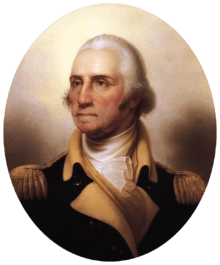
On April 23, 1775, the Massachusetts Provincial Congress authorized the raising of a colonial army consisting of 26 company regiments. New Hampshire, Rhode Island, and Connecticut soon raised similar but smaller forces. On June 14, 1775, the Second Continental Congress decided to proceed with the establishment of a Continental Army for purposes of common defense, adopting the forces already in place outside Boston (22,000 troops) and New York (5,000). It also raised the first ten companies of Continental troops on a one-year enlistment, riflemen from Pennsylvania, Maryland, Delaware and Virginia to be used as light infantry, who became the 1st Continental Regiment in 1776. On June 15, 1775, the Congress elected by unanimous vote George Washington as Commander-in-Chief, who accepted and served throughout the war without any compensation except for reimbursement of expenses.[3] Supporting Washington as commander in chief were four major-generals (Artemas Ward, Charles Lee, Philip Schuyler, and Israel Putnam) and eight brigadier-generals (Seth Pomeroy, Richard Montgomery, David Wooster, William Heath, Joseph Spencer, John Thomas, John Sullivan, and Nathanael Greene) As the Continental Congress increasingly adopted the responsibilities and posture of a legislature for a sovereign state, the role of the Continental Army became the subject of considerable debate. Some Americans had a general aversion to maintaining a standing army; but on the other hand the requirements of the war against the British required the discipline and organization of a modern military. As a result, the army went through several distinct phases, characterized by official dissolution and reorganization of units.[4]
Broadly speaking, Continental forces consisted of several successive armies, or establishments:
- The Continental Army of 1775, comprising the initial New England Army, organized by Washington into three divisions, six brigades, and 38 regiments. Major General Philip Schuyler's ten regiments in New York were sent to invade Canada.
- The Continental Army of 1776, reorganized after the initial enlistment period of the soldiers in the 1775 army had expired. Washington had submitted recommendations to the Continental Congress almost immediately after he had accepted the position of Commander-in-Chief, but the Congress took time to consider and implement these. Despite attempts to broaden the recruiting base beyond New England, the 1776 army remained skewed toward the Northeast both in terms of its composition and of its geographical focus. This army consisted of 36 regiments, most standardized to a single battalion of 768 men strong and formed into eight companies, with a rank-and-file strength of 640.
- The Continental Army of 1777–1780 evolved out of several critical reforms and political decisions that came about when it became apparent that the British were sending massive forces to put an end to the American Revolution. The Continental Congress passed the "Eighty-eight Battalion Resolve", ordering each state to contribute one-battalion regiments in proportion to their population, and Washington subsequently received authority to raise an additional 16 battalions. Enlistment terms extended to three years or to "the length of the war" to avoid the year-end crises that depleted forces (including the notable near-collapse of the army at the end of 1776, which could have ended the war in a Continental, or American, loss by forfeit)
- The Continental Army of 1781–82 saw the greatest crisis on the American side in the war. Congress was bankrupt, making it very difficult to replenish the soldiers whose three-year terms had expired. Popular support for the war reached an all-time low, and Washington had to put down mutinies both in the Pennsylvania Line and in the New Jersey Line. Congress voted to cut funding for the Army, but Washington managed nevertheless to secure important strategic victories.
- The Continental Army of 1783–84 was succeeded by the United States Army, which persists to this day. As peace was restored with the British, most of the regiments were disbanded in an orderly fashion, though several had already been diminished.
Soldiers
Soldiers in the Continental Army were volunteers; they agreed to serve in the army and standard enlistment periods lasted from one to three years. Early in the war the enlistment periods were short, as the Continental Congress feared the possibility of the Continental Army evolving into a permanent army. The army never numbered more than 17,000 men. Turnover proved a constant problem, particularly in the winter of 1776–77, and longer enlistments were approved.
The officers of both the Continental Army and the state militias were typically yeoman farmers with a sense of honor and status and an ideological commitment to oppose British tyranny.[5] The enlisted men were very different. They came from the working class or minorities groups (Irish, German, African American). They were motivated to volunteer by specific contracts that promised bounty money; regular pay at good wages; food, clothing and medical care; companionship; and the promise of land ownership after the war. They were unruly and would mutiny if the contractual terms were not met. By 1780-81 threats of mutiny and actual mutinies were becoming serious.[6][7] Upwards of a fourth of Washington's army was Irish. Many had recently arrived and needed jobs. A lot of Irish, mainly Roman Catholics, were hostile to British rule in Ireland.[8]
The Continental Army was racially integrated, a condition the United States Army would not see again until the 1950s. During the Revolution African American slaves were promised freedom in exchange for military service by both the Continental and British armies.[9][10][11] Approximately 6,600 people of color (including African American, indigenous, and multiracial men) served with the colonial forces, and made up one fifth of the Northern Continental Army.[12][13]
In addition to the Continental Army regulars, state militia units were assigned for short-term service and fought in campaigns throughout the war. Sometimes the militia units operated independently of the Continental Army, but often local militias were called out to support and augment the Continental Army regulars during campaigns. The militia troops developed a reputation for being prone to premature retreats, a fact that General Daniel Morgan integrated into his strategy at the Battle of Cowpens and fooled the British in 1781.[14]
The financial responsibility for providing pay, food, shelter, clothing, arms, and other equipment to specific units was assigned to states as part of the establishment of these units. States differed in how well they lived up to these obligations. There were constant funding issues and morale problems as the war continued. This led to the army offering low pay, often rotten food, hard work, cold, heat, poor clothing and shelter, harsh discipline, and a high chance of becoming a casualty.[15]
Keeping the continentals clothed was a difficult task and to do this Washington appointed James Mease, a merchant from Philadelphia. Mease worked closely with state-appointed agents to purchase clothing and things such as cow hides to make clothing and shoes for soldiers. Mease had eventually resigned in 1777 and had compromised much of the organization of the Clothing Department. After this on many accounts the soldiers of the Continental Army often were poorly clothed and had little blankets and often did not even have shoes. The problem with clothing and having shoes for soldiers was often not the fault of not having enough but the organization and lack of transportation. To reorganize the Board of War was appointed to sort out the clothing supply chain. During this time they sought out the help of France and for the remainder of the war, clothing was coming from over-sea procurement.[16]
Operations
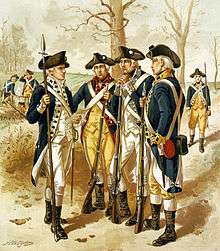
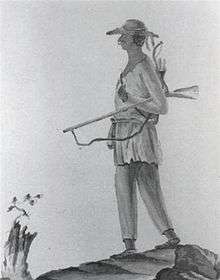
%2C_by_Jean-Baptiste-Antoine_DeVerger.png)
At the time of the Siege of Boston, the Continental Army at Cambridge, Massachusetts, in June 1775, is estimated to have numbered from 14–16,000 men from New England (though the actual number may have been as low as 11,000 because of desertions). Until Washington's arrival, it remained under the command of Artemas Ward. The British force in Boston was increasing by fresh arrivals. It numbered then about 10,000 men. The British controlled Boston, and defended it with their fleet, but were outnumbered and did not attempt to challenge the American control of New England. Washington selected young Henry Knox, a self educated strategist, to take charge of the artillery from a forgotten British fort in upstate New York, and dragged across the snow to and placed them in the hills surrounding Boston in March 1776.[17] The British situation was untenable. The negotiated an uneventful abandonment of the city, and relocated their forces to Halifax in Canada. Washington relocated his army to New York. For the next five years, the main bodies of the Continental and British armies campaigned against one another in New York, New Jersey, and Pennsylvania. These campaigns included the notable battles of Trenton, Princeton, Brandywine, Germantown, and Morristown, among many others.
The army increased its effectiveness and success rate through a series of trials and errors, often at great human cost. General Washington and other distinguished officers were instrumental leaders in preserving unity, learning and adapting, and ensuring discipline throughout the eight years of war. In the winter of 1777–1778, with the addition of Baron von Steuben, a Prussian expert, the training and discipline of the Continental Army was dramatically upgraded to modern European standards.[18] (This was the infamous winter at Valley Forge.) Washington always viewed the Army as a temporary measure and strove to maintain civilian control of the military, as did the Continental Congress, though there were minor disagreements about how this was to be carried out.
Throughout its existence, the Army was troubled by poor logistics, inadequate training, short-term enlistments, interstate rivalries, and Congress's inability to compel the states to provide food, money or supplies. In the beginning, soldiers enlisted for a year, largely motivated by patriotism; but as the war dragged on, bounties and other incentives became more commonplace. Major and minor mutinies—56 in all—diminished the reliability of two of the main units late in the war.[19]
The French played a decisive role in 1781 as Washington's Army was augmented by a French expeditionary force (under General Rochambeau) and a squadron of the French navy (under the Comte de Barras). By disguising his movements, Washington moved the combined forces South to Virginia without the British commanders in New York realizing it. This resulted in the capture of the main British invasion force in the South at Siege of Yorktown. The Americans and their allies had won the land war in North America and independence was assured. Before the peace treaty went into effect in 1783, the British partly recovered by defeating the French fleet.
Demobilization
A small residual force remained at West Point and some frontier outposts until Congress created the United States Army by their resolution of June 3, 1784.
Planning for the transition to a peacetime force had begun in April 1783 at the request of a congressional committee chaired by Alexander Hamilton. The commander-in-chief discussed the problem with key officers before submitting the army's official views on 2 May. Significantly, there was a broad consensus of the basic framework among the officers. Washington's proposal called for four components: a small regular army, a uniformly trained and organized militia, a system of arsenals, and a military academy to train the army's artillery and engineer officers. He wanted four infantry regiments, each assigned to a specific sector of the frontier, plus an artillery regiment. His proposed regimental organizations followed Continental Army patterns but had a provision for increased strength in the event of war. Washington expected the militia primarily to provide security for the country at the start of a war until the regular army could expand—the same role it had carried out in 1775 and 1776. Steuben and Duportail submitted their own proposals to Congress for consideration.
Although Congress declined on May 12 to make a decision on the peace establishment, it did address the need for some troops to remain on duty until the British evacuated New York City and several frontier posts. The delegates told Washington to use men enlisted for fixed terms as temporary garrisons. A detachment of those men from West Point reoccupied New York without incident on November 25. When Steuben's effort in July to negotiate a transfer of frontier forts with Major General Frederick Haldimand collapsed, however, the British maintained control over them, as they would into the 1790s. That failure and the realization that most of the remaining infantrymen's enlistments were due to expire by June 1784 led Washington to order Knox, his choice as the commander of the peacetime army, to discharge all but 500 infantry and 100 artillerymen before winter set in. The former regrouped as Jackson's Continental Regiment under Colonel Henry Jackson of Massachusetts. The single artillery company, New Yorkers under John Doughty, came from remnants of the 2nd Continental Artillery Regiment.
Congress issued a proclamation on October 18, 1783, which approved Washington's reductions. On November 2, Washington, then at Rockingham near Rocky Hill, New Jersey, released his Farewell Orders issued to the Armies of the United States of America to the Philadelphia newspapers for nationwide distribution to the furloughed men. In the message he thanked the officers and men for their assistance and reminded them that "the singular interpositions of Providence in our feeble condition were such, as could scarcely escape the attention of the most unobserving; while the unparalleled perseverance of the Armies of the United States, through almost every possible suffering and discouragement for the space of eight long years, was little short of a standing Miracle."[20]
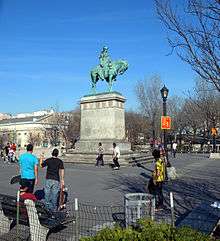
Washington believed that the blending of persons from every colony into "one patriotic band of Brothers" had been a major accomplishment, and he urged the veterans to continue this devotion in civilian life.
Washington said farewell to his remaining officers on December 4 at Fraunces Tavern in New York City. On December 23 he appeared in Congress, then sitting at Annapolis, and returned his commission as commander-in-chief: "Having now finished the work assigned me, I retire from the great theatre of Action; and bidding an Affectionate farewell to this August body under whose orders I have so long acted, I here offer my Commission, and take my leave of all the employments of public life." Congress ended the War of American Independence on January 14, 1784, by ratifying the definitive peace treaty that had been signed in Paris on September 3.
Congress had again rejected Washington's concept for a peacetime force in October 1783. When moderate delegates then offered an alternative in April 1784 which scaled the projected army down to 900 men in one artillery and three infantry battalions, Congress rejected it as well, in part because New York feared that men retained from Massachusetts might take sides in a land dispute between the two states. Another proposal to retain 350 men and raise 700 new recruits also failed. On June 2 Congress ordered the discharge of all remaining men except twenty-five caretakers at Fort Pitt and fifty-five at West Point. The next day it created a peace establishment acceptable to all interests.
The plan required four states to raise 700 men for one year's service. Congress instructed the Secretary at War to form the troops into eight infantry and two artillery companies. Pennsylvania, with a quota of 260 men, had the power to nominate a lieutenant colonel, who would be the senior officer. New York and Connecticut each were to raise 165 men and nominate a major; the remaining 110 men came from New Jersey. Economy was the watchword of this proposal, for each major served as a company commander, and line officers performed all staff duties except those of chaplain, surgeon, and surgeon's mate. Under Josiah Harmar, the First American Regiment slowly organized and achieved permanent status as an infantry regiment of the new Regular Army. The lineage of the First American Regiment is carried on by the 3rd United States Infantry Regiment (The Old Guard).
However the United States military realized it needed a well-trained standing army following St. Clair's Defeat on November 4, 1791, when a force led by General Arthur St. Clair was almost entirely wiped out by the Western Confederacy near Fort Recovery, Ohio. The plans, which were supported by U.S. President George Washington and Henry Knox, Secretary of War, led to the disbandment of the Continental Army and the creation of the Legion of the United States. The command would be based on the 18th-century military works of Henry Bouquet, a professional Swiss soldier who served as a colonel in the British army, and French Marshal Maurice de Saxe. In 1792 Anthony Wayne, a renowned hero of the American Revolutionary War, was encouraged to leave retirement and return to active service as Commander-in-Chief of the Legion with the rank of Major General.
The legion was recruited and raised in Pittsburgh, Pennsylvania. It was formed into four sub-legions. These were created from elements of the 1st and 2nd Regiments from the Continental Army. These units then became the First and Second Sub-Legions. The Third and Fourth Sub-Legions were raised from further recruits. From June 1792 to November 1792, the Legion remained cantoned at Fort LaFayette in Pittsburgh. Throughout the winter of 1792–93, existing troops along with new recruits were drilled in military skills, tactics and discipline at Legionville on the banks of the Ohio River near present-day Baden, Pennsylvania. The following Spring the newly named Legion of the United States left Legionville for the Northwest Indian War, a struggle between American Indian tribes affiliated with the Western Confederacy in the area south of the Ohio River. The overwhelmingly successful campaign was concluded with the decisive victory at the Battle of Fallen Timbers on August 20, 1794, Maj. Gen. Anthony Wayne applied the techniques of wilderness operations perfected by Sullivan's 1779 expedition against the Iroquois. The training the troops received at Legionville was also seen as an instrumental to this overwhelming victory.
Nevertheless, Steuben's Blue Book remained the official manual for the legion, as well as for the militia of most states, until Winfield Scott in 1835. In 1796, the United States Army was raised following the discontinuation with the legion of the United States. This preceded the graduation of the first cadets from United States Military Academy at West Point, New York, which was established in 1802.
Rank insignia

During the American Revolutionary War, the Continental Army initially wore ribbons, cockades and epaulettes of various colors as an ad hoc form of rank insignia, as General George Washington wrote in 1775:
"As the Continental Army has unfortunately no uniforms in 1775, and consequently many inconveniences must arise from not being able to distinguish the commissioned officers from the privates, it is desired that some badge of distinction be immediately provided; for instance that the field officers may have red or pink colored cockades in their hats, the captains yellow or buff, and the subalterns green."
In 1776 captains were to have buff or white cockades.
| Rank insignia of the Continental Army 1775[21] | |||||||||
|---|---|---|---|---|---|---|---|---|---|
| Ribands across the breast | Cockades in the hats | Epaulettes or stripes on the right shoulder | |||||||
| General and commander-in-chief |
Major general | Brigadier general | Aide-de-camp | Colonel, lieutenant colonel, major |
Captain | Lieutenant, ensign | Sergeant | Corporal | |
Later on in the war, the Continental Army established its own uniform with a black and white cockade among all ranks. Infantry officers had silver and other branches gold insignia:
| Ranks and insignia of the Continental Army 1780[22] | ||||||||||||||
|---|---|---|---|---|---|---|---|---|---|---|---|---|---|---|
| Commander-in-Chief | Major general | Brigadier general | Colonel | Lieutenant colonel | Major | Captain | Subaltern | Sergeant major | Sergeant | Corporal | Private | |||
| Two epaulettes, with three six-pointed stars | Two epaulettes, with two stars |
Two epaulettes, with one star |
Two epaulettes |
Two epaulettes |
Two epaulettes |
One epaulette (Right shoulder) |
One epaulette (Left shoulder) |
Two red epaulettes |
One red epaulette (Right shoulder) |
One green epaulette (Right shoulder) |
No epaulettes | |||
  |
 |
 |
 |
 |
 |
 |
  |
 |
||||||
Major battles
- Siege of Boston
- Battle of Long Island
- Battle of Harlem Heights
- Battle of Trenton
- Battle of the Assunpink Creek
- Battle of Princeton
- Battle of Brandywine
- Battle of Germantown
- Battle of Saratoga
- Battle of Monmouth
- Siege of Charleston
- Battle of Camden
- Battle of Cowpens
- Battle of Guilford Court House
- Siege of Yorktown
See also
- Pluckemin Continental Artillery Cantonment Site
- History of the United States Army
- Regulations for the Order and Discipline of the Troops of the United States
- Peter Francisco, Revolutionary War soldier and hero
- Middlebrook encampment near Middlebrook, New Jersey
- First Middlebrook encampment (1777)
- Second Middlebrook encampment (1778–79)
- Jockey Hollow, near Morristown, New Jersey, winter of 1779–80
- New Jersey Brigade Encampment Site, adjacent to Jockey Hollow, winter of 1779–80
- List of infantry weapons in the American Revolution
- List of George Washington articles
- George Washington in the American Revolution
References
Citations
- Rogoway, Tyler (July 4, 2014). "The Revolutionary War: By The Numbers". Foxtrot Alpha. Jalopnik. Retrieved November 16, 2018.
80,000 militia and Continental Army soldiers served at the height of the war
- Wright, 1983, pp. 10–11
- Edward G. Lengel, General George Washington: A Military Life"" (2005) pp 87-101.
- Don Higginbotham, The War of American Independence: Military Attitudes, Policies, and Practice, 1763-1789 (1971) pp 81-97, 204-225.
- Caroline Cox, A Proper Sense of Honor: Service and Sacrifice in George Washington's Army (2004) pp. xv-xvii.
- Charles Patrick Neimeyer, America Goes to War: A Social History of the Continental Army (1995) pp 148-55. complete text online.
- David Hackett Fischer, Washington's crossing (2004) pp 7-30.
- Neimeyer, America Goes to War, pp 36-38.
- Liberty! The American Revolution (Documentary) Episode II: Blows Must Decide: 1774–1776. Twin Cities Public Television, 1997. ISBN 1-4157-0217-9
- Jack D. Foner, Blacks and the military in American history (1974) pp 3-19.
- Neimeyer, America Goes to War, pp 65-88.
- Benjamin Quarles, The Negro in the American Revolution (1961) oenline
- Eric Grundset, editor, Forgotten Patriots, produced by the Daughters of the American Revolution, 2008, https://www.dar.org/sites/default/files/media/library/DARpublications/Forgotten_Patriots_ISBN 978-1-892237-10-1.pdf
- Robert C. Pugh, "The Revolutionary Militia in the Southern Campaign, 1780-1781." William and Mary Quarterly (1957) 14#2: 154-175 online.
- E. Wayne Carp, To Starve the Army at Pleasure: Continental Army Administration and American Political Culture, 1775-1783 (1990).
- "Continental Army Logistics: Clothing Supply". Defense Transportation Journal. 32 (5): 28–34. 1976. JSTOR 44120928.
- Marc G. DeSantis, "Behind the Lines: Train Man: When the Continental Army captured a huge cache of British artillery at Fort Ticonderoga, George Washington turned to Henry Knox to get them to Boston," MHQ: Quarterly Journal of Military History (Autumn 2017) 30#1 pp 24-26.
- Stephen C. Danckert, "Baron von Steuben and the Training of Armies." Military Review 74 (1994): 29-34 in EBSCO
- John A. Nagy, Rebellion in the Ranks: Mutinies of the American Revolution (2008).
- Washington, George (November 2, 1783). "Washington's Farewell Address to the Army, 2 November 1783". Founders Online, National Archives.
- Steven A. Bingaman (2013), The History of American Ranks and Rank Insignia, p. 11.
- For commissioned officers 'metal epaulettes were introduced by a general order dated June 18. 1780 (except of those of the CiC). For non-commissioned officers cloth epaulettes were prescribed since a general order dated July 23. 1775. That order differentiated only between the ranks of serjeant and corporal. At the end of war, the serjeant-major was recognizable by a pair of cloth epaulettes. The number, position and color of the NCO-epaulettes was changed for several times.
Sources and further reading
- Billias, George Athan, ed., George Washington's Generals (1980)
- Bodle, Wayne. The Valley Forge Winter: Civilians and Soldiers in War (2002)
- Carp, E. Wayne. To Starve the Army at Pleasure: Continental Army Administration and American Political Culture, 1775–1783. (U of North Carolina Press, 1984). ISBN 0-8078-1587-X.
- Cox, Caroline. A Proper Sense of Honor: Service and Sacrifice in George Washington's Army (2004).
- Ferling, John. Whirlwind: The American Revolution and the War That Won It (2015).
- Fleming, Thomas. The Strategy of Victory: How General George Washington Won the American Revolution (Hachette UK, 2017).
- Gillett, Mary C. The Army Medical Department, 1775–1818. (Washington: Center of Military History, U.S. Army, 1981).
- Higginbotham, Don. The War of American Independence: Military Attitudes, Policies, and Practice, 1763-1789 (1971) on line.
- Lengel, Edward G. General George Washington: A Military Life. (2005).
- Martin, James Kirby, and Mark Edward Lender. A Respectable Army: The Military Origins of the Republic, 1763–1789. (2nd ed. Harlan Davidson), 2006. ISBN 0-88295-239-0.
- Mayer, Holly A. Belonging to the Army: Camp Followers and Community during the American Revolution. Columbia: University of South Carolina Press, 1999. ISBN 1-57003-339-0; ISBN 1-57003-108-8.
- Neimeyer, Charles Patrick. America Goes to War: A Social History of the Continental Army (1995) complete text online
- Palmer, Dave Richard. George Washington's Military Genius (2012).
- Risch, Erna (1981). Supplying Washington's Army. Washington, D.C.: United States Army Center of Military History.
- Royster, Charles. A Revolutionary People at War: The Continental Army and American Character, 1775–1783. (U of North Carolina Press, 1979). online
- Wright, Robert K. (1983). The Continental Army. Center of Military History, U.S. Army., 451 pages, eBook
- Bibliography of the Continental Army compiled by the United States Army Center of Military History
Primary sources
- Commager, Henry Steele, and Richard Brandon Morris, eds. The spirit of 'seventy-six: the story of the American Revolution as told by participants (1975). online
- Scheer, George F. Private Yankee Doodle: A Narrative of Some of the Adventures, Dangers and Sufferings of a Revolutionary Soldier [Joseph Plumb Martin]. (1962).
- Wright Jr., Robert K.; MacGregor Jr., Morris J. "Resolutions of the Continental Congress Adopting the Continental Army and other Sources from the Revolution". Soldier-Statesmen of the Constitution. E302.5.W85 1987. Washington D.C.: United States Army Center of Military History. CMH Pub 71-25.
- RevWar75.com provides "an online cross-referenced index of all surviving orderly books of the Continental Army".
